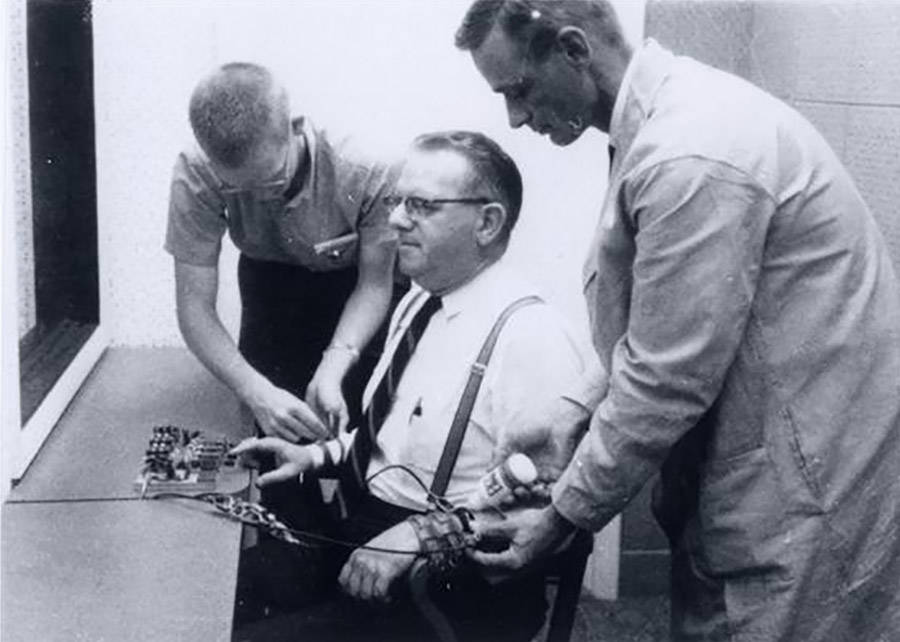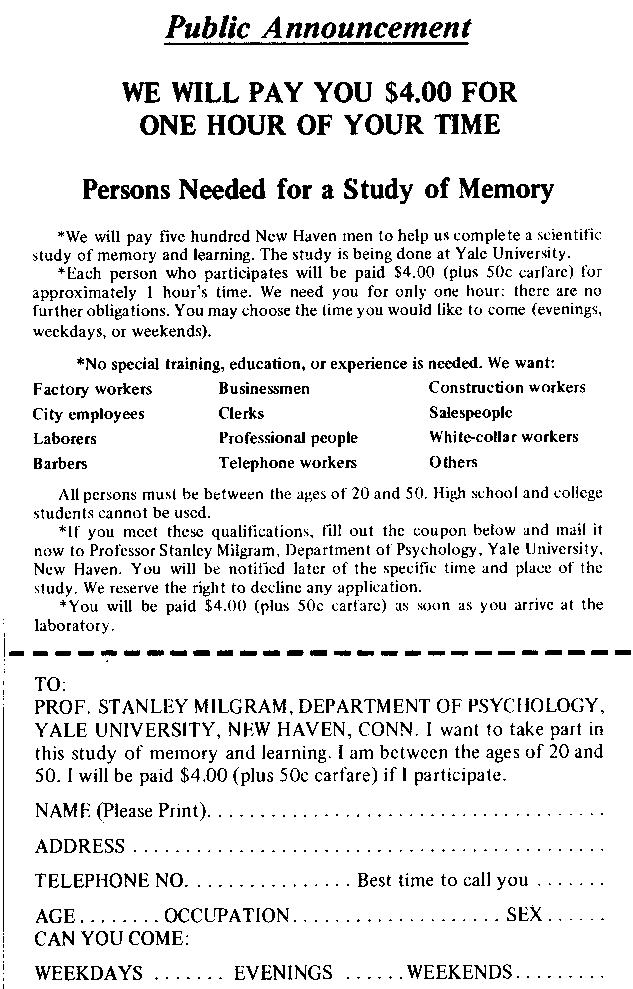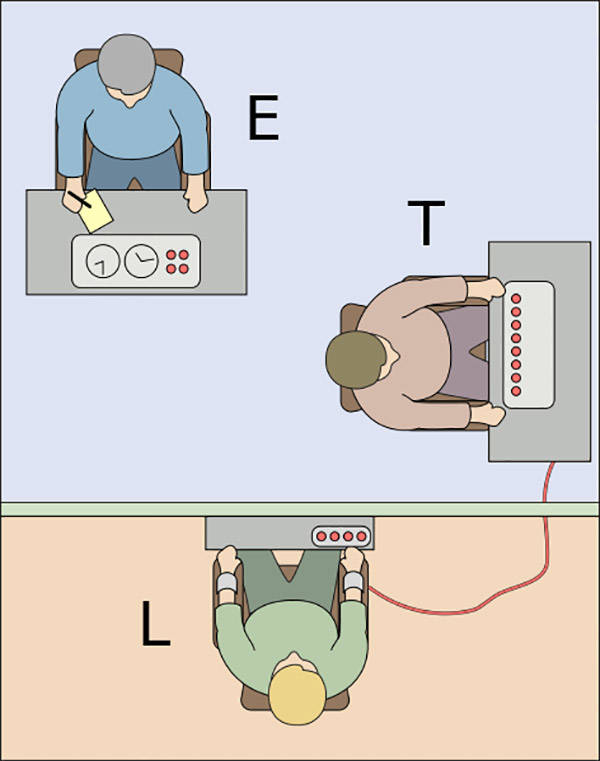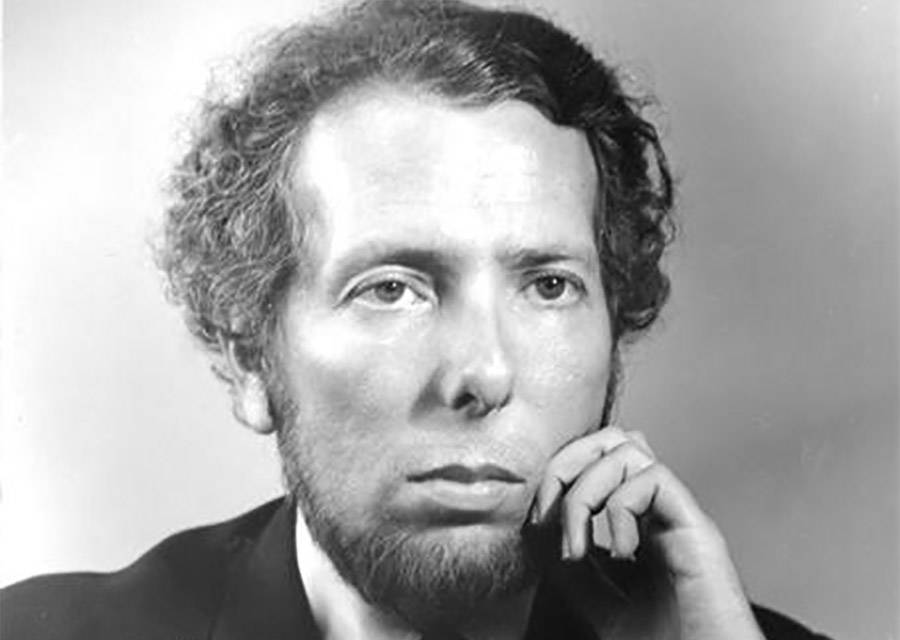The Milgram experiment tested its subjects' willingness to harm other people for the sake of obeying authority — and it ended with truly shocking results.

Yale University Manuscripts and ArchivesParticipants in one of Stanley Milgram’s experiments that examined obedience to authority.
In April 1961, former Nazi official and SS Colonel Adolf Eichmann went on trial for crimes against humanity in an Israeli courtroom.
Throughout his trial, which ended with a conviction and death sentence, Eichmann had tried to defend himself on the grounds that he was “only following orders.” He asserted that he was not a “responsible actor,” but merely a servant of those who were, and so he should be held morally blameless for just doing his duties, even if they included organizing the logistics of shipping people to the Nazi camps during the war.
This defense didn’t work in court and he was convicted on all counts. However, the idea of an unwilling-but-obedient participant in mass murder captured the interest of Yale psychologist Stanley Milgram, who wanted to know how easily morally normal people could be convinced to commit heinous crimes after an authority figure ordered them to do so.
To examine the matter, Milgram polled dozens of people for their opinions. Without exception, every group he asked for predictions thought it would be difficult to get people to commit serious crimes just by ordering them to.
Only three percent of the Yale students Milgram polled said that they thought an average person would willingly kill a stranger just because an authority figure pressured them into it. A poll of colleagues on the staff of a medical school showed similar results, with only around four percent of faculty psychologists guessing test subjects would knowingly kill a person if they were coerced into it by someone who looked like they were in charge.
In July 1961, Milgram set out to discover the truth for himself by devising an experiment, the results of which are still controversial to this day.
What Was The Milgram Experiment?

Wikimedia CommonsAn advertisement to participate in the Milgram experiment in 1961.
The experiment Milgram set up required three people. One person, the test subject, would be told he was participating in a memorization experiment, and that his role would be to administer a series of electric shocks to a stranger whenever he failed to correctly answer a question.
In front of the subject was a longboard with 30 switches labeled with increasing voltage levels, up to 450 volts. The last three switches had high-voltage warnings pasted on them and appeared to be very dangerous.
The second participant was an actor and confederate, who would chat with the test subject before moving to an adjacent room and connecting a tape recorder to the electrical switches so that they could play recorded shouts and screams — which sounded like their reaction to getting “shocked.”
The third participant was a man in a white lab coat, who sat behind the test subject and pretended to administer the test to the actor in the next room.
What Happened When The “Test-Takers” Failed Their Tests?

Wikimedia CommonsIllustration of the setup of the Milgram experiment. The experimenter (E) convinces the subject (“Teacher” T) to give what he believes are painful electric shocks to another subject, who is actually an actor (“Learner” L).
At the beginning of the experiment, the test subject would be given a quick shock from the apparatus on its lowest power level. Milgram included this to ensure that the subject knew how painful the shocks were and to make the pain of the shocks “real” to the subject before proceeding.
As the experiment got underway, the administrator would give the unseen confederate a series of memorization problems requiring an answer. When the actor gave the wrong answer, the administrator would instruct the subject to flip the next switch in the sequence so that they were seemingly delivering progressively higher-voltage shocks to the confederate.
When the switch was thrown, the tape recorder would play a yelp or a scream, and at higher levels, the confederate would start pounding on the wall and demanding to be set free. The actor was also given scripted lines about having a heart condition to make the situation seem very urgent.
After the seventh shock, he would go completely silent to give the impression that he had either passed out or died. When this happened, the administrator would continue on with his questions.
Getting no response from the “unconscious” confederate, the administrator told the subject to apply higher and higher shocks, up to the last, 450-volt switch, which was colored red and labeled as potentially lethal.
The Results Of The Milgram Experiment

Yale University Manuscripts and ArchivesParticipants in the Milgram experiment.
The groups that Milgram polled before the experiments began had predicted that just three or four percent of test subjects could be convinced to deliver a potentially fatal electric shock to an unwilling participant.
But results showed that 26 of the 40 subjects — 65 percent — went all the way up to 450 volts during the experiment. Furthermore, all of them had been willing to deliver 300 volts to a screaming and protesting subject.
All of the subjects had raised some kind of objection during the test. However, Milgram was astounded to find out that, apparently, almost two-thirds of normal people would be willing to kill a person with electricity if a man in a lab coat told them, “It is imperative that you continue.”
Accordingly, after the initial experiment was over, Milgram organized more tests with some variables controlled to see what importance different factors had in affecting people’s resistance to authority.
He found that people are vastly more likely to carry out atrocious acts if they feel like they have permission from some recognized authority (such as a scientist in a lab coat or a senior officer in the SS) and that participants’ willingness to shock increases as they are made to feel that the authority has taken moral responsibility for the actions they commit.

Yale University Manuscripts and ArchivesMost participants in the Milgram experiment apparently believed they were delivering electric shocks to strangers.
Here are some other findings from the Milgram experiment:
- When instructions to shock are given by phone, rather than having the authority figure physically present in the room, compliance dropped to 20.5 percent, and many “compliant” subjects were actually cheating; they would skip shocks and pretend to have thrown the switch when they hadn’t.
- When the subjects were made to press the victim’s hand down onto a shock plate, thus eliminating the distance of throwing an impersonal switch, compliance dropped to 30 percent.
- When the subjects were put in the position of ordering other people — confederates who were part of the experiment staff — to throw the switches, compliance increased to 95 percent. Putting one person between the subject and the victim made it so that 9.5 out of 10 people went all the way up to the presumed-fatal shock.
- When subjects were given “role models” to set an example of resistance, in this case, confederates who raised objections and refused to participate, compliance plunged to only 10 percent. It’s as if the subjects really wanted to stop, but needed leadership to grant moral permission to disobey an authority figure.
- When the administrator participated without the lab coat, that is, without a uniform indicating authority, compliance fell to 20 percent.
- Experiments held at locations separate from the prestigious Yale campus yielded less compliance, only 47.5 percent as if the perceived status of the surroundings had some conforming influence on the subjects.
The Legacy Of The Milgram Experiment

Yale University Manuscripts and ArchivesSome believed that Stanley Milgram’s experiment was unethical, and others thought that his results said more about the types of people who participated in psychology experiments at Yale than people in general.
They say nothing in the social sciences is ever proven, and the disturbing results of Milgram’s experiment are no exception. Milgram’s work with his subjects faced criticism from other experts in the psychology community almost as soon as his results were published.
One of the more serious charges leveled against Milgram’s paper was the original sin of social science research: sample bias.
It was convincingly argued that even though the 40 local men Milgram had recruited for his research varied in backgrounds and professions, they represented a special case and that such a small group of white males may not be the most representative sample of humanity. Therefore, Milgram’s work had limited value in understanding human psychology.
In fact, critics argued, Milgram may have discovered something alarming about the kind of person who participates in psychology experiments at Yale, but such people would be expected to be more conformist and eager to please authority figures than a truly representative sample of the populace.
This critique was lent some weight when later researchers had trouble reproducing Milgram’s findings. Other investigators, using less-biased samples drawn from other groups in the population, found significantly less compliance with the administrators’ requests. Many reported meeting stiff resistance from non-college-educated and working-class people.

Yale University Manuscripts and ArchivesThe Milgram experiment is still considered one of history’s most controversial psychology experiments.
The results seemed to plot a curve of compliant behavior, from the very top of society (wealthy, white, upper-class overachievers) to the lowest (unemployed, racially diverse school dropouts).
Those who had risen the highest seemed more eager to shock strangers to death when a man in a lab coat asked them to. It was theorized that others who may have had negative experiences with authorities were generally willing to argue and quit the experiment before things went too far.
Though some continue to muse about the results of the Milgram experiment and others have performed different versions of it in recent years, it’s unlikely anyone will ever completely replicate it again in its original form.
The intense psychic stress that test subjects have to be put through, as they are led to believe they’re committing what amounts to murder, violates many of the ethical restrictions now in place for human research. Another problem is the notoriety of the experiment — too many people know about the experiment now to ensure honest performance from the test group.
Whatever the Milgram experiment’s faults, and however hard it might be in the future to make sense of its findings, the fact that so many seemingly normal men felt compelled to violate their own conscience to obey authority is enough to send chills up the spines of many people even today.
After learning about the Milgram experiment, read about Unit 731, Japan’s sickening human experiments program during World War II. Then, learn about the infamous Stanford Prison Experiment.





